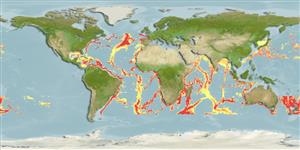Preferred temperature (Ref.
123201): 2.3 - 5, mean 3.3 °C (based on 1404 cells).
Índice de diversidade filogenética (Ref.
82804): PD
50 = 1.0000 [Uniqueness, from 0.5 = low to 2.0 = high].
Bayesian length-weight: a=0.00085 (0.00033 - 0.00223), b=3.07 (2.84 - 3.30), in cm total length, based on LWR estimates for this (Sub)family-body shape (Ref.
93245).
Nível Trófico (Ref.
69278): 3.3 ±0.36 se; based on food items.
Resiliência (Ref.
120179): Baixo, tempo mínimo de duplicação da população 4,5 - 14 anos (Assuming tmax>10).
Fishing Vulnerability (Ref.
59153): Moderate vulnerability (41 of 100).
🛈
Nutrients (Ref.
124155): Calcium = 12.2 [3.5, 43.0] mg/100g; Iron = 0.426 [0.139, 1.080] mg/100g; Protein = 2.36 [0.00, 6.23] %; Omega3 = 0.308 [0.110, 0.875] g/100g; Selenium = 24.3 [6.7, 82.0] μg/100g; VitaminA = 5.02 [0.95, 23.69] μg/100g; Zinc = 0.317 [0.164, 0.626] mg/100g (wet weight);
